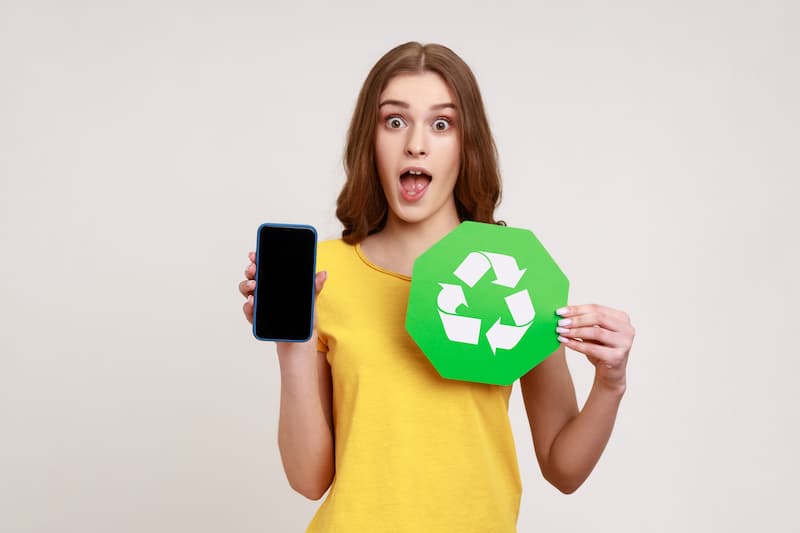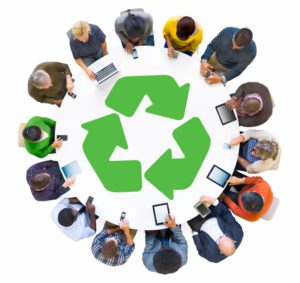How Are Phone Manufacturers Improving Their Sustainability?

Sustainability is at the forefront of every business owner’s mind worldwide. It is even more so for the manufacturers of smartphones. As the demand for phones grows, so does the demand for environmentally responsible products and the need to address the growing concern of e-waste internationally.
At Mazuma, sustainability and providing new life for old phones is at the heart of our business. However, how much effort is being taken by the industry giants responsible for making the phones? We look at what actions are being taken, particularly with the two biggest giants in tech, to reduce the impact of smartphones on the environment.
Recycling and reusing materials
There are many ways the big manufacturers are improving production; the most important is using recycled materials. For instance, Samsung, the leading android phone manufacturer, uses ocean-bound plastics such as discarded fishing nets to produce plastic components within their Galaxy range of phones. They also use it for the casings and details of their wearable tech, such as earbuds and smartwatches.
Apple, another big player in the world of phones, also reuses recycled materials to create its range of iPhones. For example, in 2021, 59% of all the aluminium Apple used within its products came from recycled sources. In addition, all new iPhones, iPads, AirPods and Macs feature 100% recycled tin in their main logic motherboard solder.

However, one of the biggest issues faced by every phone manufacturer was the use of plastic. The most significant way the tech industry solves this problem is by using PCM plastic (Post Consumer Material). This plastic has already lived its life in the form of something else, such as plastic bottles and carrier bags. By recycling these everyday items, the plastic is made into pellets that can be remoulded into new products. The use of PCM is part of many industries’ efforts to aim for a circular economy in which products are put back into the circle of production with the help of phone recycling facilities like ours.
Reducing the carbon footprint of your phone
A carbon footprint measures the total amount of greenhouse gases emitted into the atmosphere due to human activities, including burning fossil fuels, deforestation, and other land use changes. It is often expressed in terms of equivalent tons of CO2 and is used to understand and quantify the environmental impact of individual activities, organisations, and entire countries.
Samsung is promising to reduce carbon emissions with its range of smart technology, allowing users to lower their own carbon footprints with their product. They also offer their action plan, which addresses the risks within their carbon footprint and their goals to lower these each year to improve their sustainability. Apple also products that reduce the user’s carbon footprint, with the likes of their Apple TV box, which reduces carbon footprint by up to 34%. Apple has also been carbon neutral since 2020 and aims to have all their products carbon neutral by 2030.

Companies can improve their carbon footprint in various ways, including carbon offsetting, strict supply chain management and renewable energy sources supplying factories and offices. Most large phone manufacturers are being transparent in their aims to become more sustainable each year, with reports and plans visible on their websites. So if you are ever curious about the business behind your tech, check them out before buying their products for a more eco-conscious purchase.
Developing longer-lasting products
We all remember the scandal from 2018, when the Italian competition authority investigated the big two phone brands and their curious updates, making some smartphones within their older collections obsolete. Both companies were fined, and although they claimed they were unaware of the issues caused to older phones by the updates, it sparked a debate on the ethical practices of making smart devices poorly designed for future updates.

The issue with smartphones is that they have come a long way from when they first came out, and naturally, phones will get left behind. For example, the iPhone 14 is a long way more advanced than the iPhone 6S, so developing updates that suit both iPhones and everything in between is not entirely practical. However, instead of making the phones obsolete, the newer updates will simply leave the phone vulnerable due to a lack of support. Any updates will no longer harm your devices, but you will be at risk for cyber-attacks. So, if you have an older device, why not consider getting a good price for it now with our sell my iPhone services?
Environmentally friendly packaging
One of the biggest issues when buying a new phone was all the unnecessary packaging it came with. Like most tech, there was an array of plastic wrap, polystyrene and plastic shells to keep everything in place. This is not only a waste of resources but also a nightmare when it comes to bin day after Christmas.
To combat this waste, many phone companies are addressing their packaging and what is really required for a new phone. The plugs are one of the most noticeable recent removals from the box of new phones. Although these are essential for providing power for your phone to charge, most homes already have an abundance of them from previous phones and devices. Many homeowners are also changing their plug sockets to USB-compatible sockets removing the need for plugs altogether. This allowed many big brands of phones to take the plug out of the box, which helped to reduce unnecessary e-waste and even made the box much smaller, needing fewer materials.

If you have bought a phone recently, you may have noticed very little printed on the box. In fact, if you were to buy a Samsung TV, you would see it is almost entirely brown with minimal information. Lack of printing helps reduce the ink needed to print onto the box, which also became an issue when the box needed to be recycled. This new basic design is much more environmentally friendly and can be done using pre-recycled materials.
Next time you get a new phone, consider what is missing since the last time you bought one. Companies are working throughout the entire supply chain to reduce unnecessary packaging for products. Even the instruction booklet which comes with your shiny new phone is minimal, with everything else accessible online through the help of QR codes and links. The change is minimal but has greatly impacted the waste produced and the overall carbon footprint of a device.
Trade-in services and phone recycling
Obviously, achieving a circular economy, the aim of most tech industries, can only be made possible by selling your old phone back to the manufacturer. Most big names in phones will offer some form of a phone trade-in when you upgrade to help minimise the products heading to landfill and allow them to recycle the parts within their new phones.
However, whilst we may not be able to manufacture the latest iPhone or Galaxy S24 (although you can buy many of the latest phones through our refurbished phones site), we do know a thing or two about recycling.

Much like the industry’s tech giants, we at Mazuma are also looking to achieve a more sustainable planet. Our mission is to provide new old phones with new life due to programs such as our incredible Samsung trade-in services. Unlike the big names, recycling phones is our only mission, which means we are pretty much the experts. We offer some of the best prices online for many iPhones and android phones instead of a set figure. So, for example, when you sell an iPhone with us, we don’t provide you discounts or money off a new product; we offer you cash directly to your bank, often the same day we get your phone.
By selling your broken phones with Mazuma, you are still contributing to the circular economy, but you are getting more money for your device and no pressure from us to buy a new one. Our services are straightforward, easy, and honest. So when it comes to trading in your phone to help promote a sustainable future, make sure you are doing so with someone who is an expert in recycling phones.

